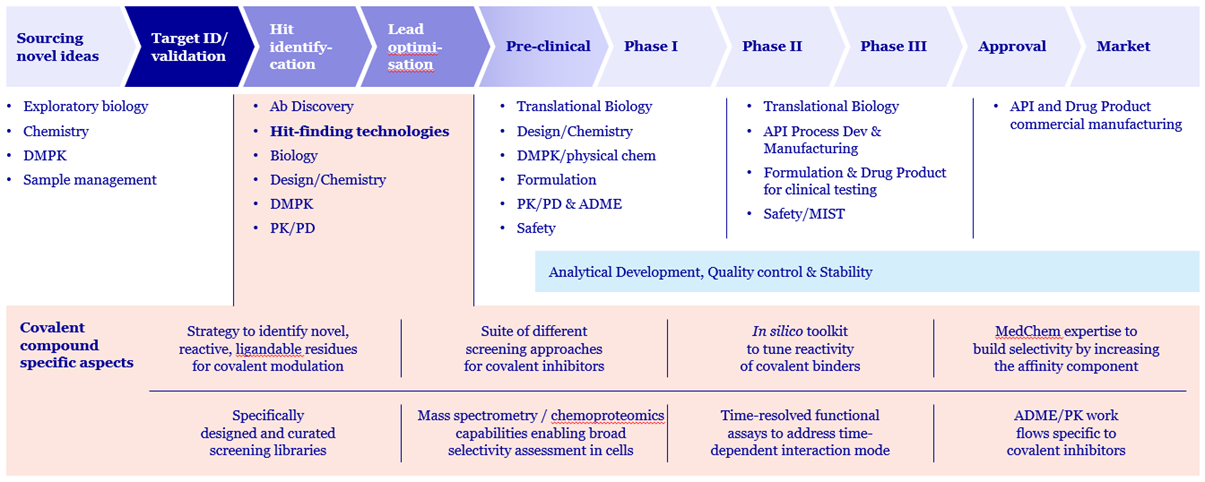
Covalent Drugs
Covalent drugs have been used to treat diseases for more than a century, but tools that facilitate the rational design of covalent drugs have emerged more recently. Covalent mechanisms of action can provide multiple advantages, including improved potency and selectivity, prolonged duration of action, and beneficial pharmacokinetics profiles, that make this approach increasingly popular in both medicinal chemistry and chemical biology settings. Furthermore, covalent binders demonstrated enhanced target occupancy and target engagement specifically on less druggable targets.
The approval of multiple covalent drugs by the FDA in the last years has prompted a resurgence of interest in this class of compounds. Key examples include the covalent Bruton’s tyrosine kinase (BTK) inhibitor Ibrutinib, the epidermal growth factor receptor (EGFR) inhibitor Osimertinib, and Sotorasib, a RAS GTPase family inhibitor developed for the treatment of solid tumours with KRAS G12C mutations.
At Evotec, we are working to reshape the future of healthcare, together with our partners, to discover and develop medicines that matter more effectively and efficaciously than ever before. To this end, we have built a unique, industry-leading end-to-end platform to discover, and develop, pre-clinical candidates including covalency approaches as a promising path to medicine discovery.
Evotec’s Strategies to ID Covalent Small Molecule Hit Compounds
The purposeful addition of reactive functional groups to existing ligands also known as “ligand-first” approach can enable potent and selective inhibition of target proteins, as demonstrated by the discovery of covalent EGFR and BTK inhibitors used to treat various cancers.
Moreover, the identification of covalent ligands through “electrophile-first” approaches has also led to the discovery of covalent drugs, such as covalent inhibitors for KRAS (G12C) and SARS-CoV-2 main protease. The use of covalent screening technologies has become more powerful and widespread over the past decade. Chemoproteomic platforms have emerged to complement covalent ligand screening and assist in ligand discovery, selectivity profiling and target identification.
Discoveries by “Ligand-First” Approaches
The most popular strategy starts with known high-affinity noncovalent compounds and introduces mildly reactive electrophilic functionalities at the position closest to the protein nucleophile targeted.
The incorporated electrophile binds irreversibly to a nucleophilic amino acid (mainly Cys, Lys, Thr, Tyr, Ser, His, and, less frequently, Glu and Met) on the target protein, introducing a covalent interaction in addition to the reversible interactions already at play.
The success of ibrutinib and covalent EGFR inhibitors has validated this approach and demonstrate that kinase inhibitors that target non-conserved cysteines adjacent to the ATP-binding site can be developed into selective and potent drugs.
Discoveries by “Electrophile-First” Approaches
Fragment-based approaches identify hits from small libraries of less complex molecules that provide many advantages over large-scale drug-like screens. Fragments (compounds with 6–16 nonhydrogen atoms) cover the larger part of the available chemical space and provide a larger hit rate for structurally diverse starting points, even for targets that failed in HTS settings. However, fragment hits have lower affinities, making their detection, validation, and optimization challenging. Screening electrophilic fragments could solve these issues because of the higher affinity and fixed binding mode of the hits and, therefore, they can be considered as viable chemical starting points for the development of not only covalent, but also noncovalent binders., Indeed, screening libraries of electrophilic fragments is a promising alternative to discover and validate novel targets and to generate viable chemical starting points even for targets that are barely tractable.
This “electrophile-first” approach is significantly facilitated by most recent development of MS-based platforms that enable rapid hit identification and selectivity profiling of covalent ligands even in live cells. Combining the advances in covalent ligand screening and chemoproteomics with In silico approaches, structural biology, and accurate structure prediction of biomolecular interactions with AlphaFold to empower medicinal chemistry has the potential to efficiently generate molecules that selectively bind and modulate the activity of challenging protein targets.
Evotec’s Proprietary Covalent Libraries
Evotec created an extensive collection of 5,300 acrylamide derivatives as cysteine modifiers. First focus was on acrylamides because of (i) the growing interest in selective covalent modification of cysteine residues, (ii) the increasing number of acrylamide-derived drugs reaching advanced clinical phases and the market (Ibrutinib, Osimertinib, and Sotorasib), (iii) our internal expertise built over years showing developability of such molecules and (iv) their long-term stability (over years), as demonstrated by their storage in our sample management facilities. This collection covers fragment and lead-like chemical spaces and was designed using a thorough molecular design workflow based on well-thought molecular descriptors, Evotec list of structural alerts, and diversity selection. The outcome of the workflow was supervised by skilled medicinal chemists experienced in covalent drug discovery.
Evotec is now extending the collection towards other protein residues that are susceptible to chemical modification, such as lysine, serine/threonine, tyrosine, aspartic/glutamic acids, methionine, arginine, and histidine. We pay particular attention to stability when creating new library sets, which has particularly high importance when dealing with reactive molecules. Hence our decision to test mid-term stability of islets of relevant chemical modifiers of various protein residues in regular storage conditions. Warheads that appear to be suitable for mid-term storage will be extended to create the “beyond cysteine” Evotec covalent collection. Evotec also uses the libraries of covalent compounds and FFFs commercially available from different suppliers (e.g. Enamine, Life Chemicals, Molport) as well as the libraries built up by his partners.
Evotec’s Covalent Drug Discovery Toolbox
Evotec provides all relevant technologies, know-how, scientists, and infrastructure to discover and boost the development of covalent medicines that target unmet medical needs. This involves all steps from research to development of covalent drug candidates. We offer expertise in design, synthesis, hit identification screening, lead optimization, modification chemistry, ADME-DMPK/ early toxicology, and IND-enabling studies across various therapeutic areas, including oncology, metabolic diseases, CNS diseases, rare diseases, infectious disease, and women's health.

